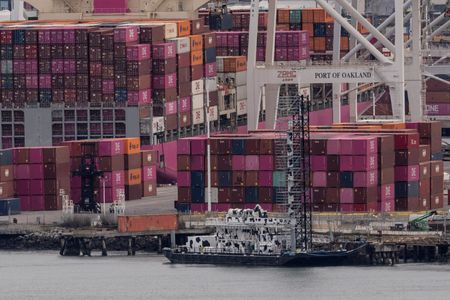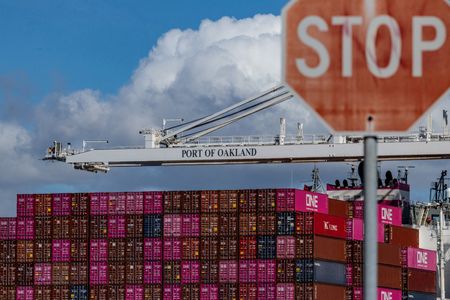By Lisa Baertlein, Victoria Waldersee and Renee Maltezou
LOS ANGELES/BERLIN/ATHENS (Reuters) -U.S. President Donald Trump’s new tariff plan has the ocean shipping industry on edge as he stokes a trade war destined to stanch transport demand and send companies scrambling to manage the fallout.
The Trump administration on Wednesday is set to announce “reciprocal tariffs” targeting nations that have duties on U.S. goods. That move would come after it slapped new import levies on products from Mexico, China and Canada – the top U.S. trading partners – as well as on goods including steel and autos.
Major global container shipping firms like MSC, Maersk, CMA CGM and Hapag-Lloyd transport towering piles of colorful boxes stuffed with goods for U.S. customers like Walmart, Target and Home Depot.
They are giants in the roughly $14 trillion a year ocean shipping industry that handles about 80% of global trade. They are also reliant on companies that are getting whipsawed by Trump’s escalating, on-and-off tariffs.
“The implementation of stacked tariffs has led to mounting confusion,” said Blake Harden, the Retail Industry Leaders Association’s vice president of international trade. “Companies have not had adequate time, certainty, and guidance they need to incorporate these changes and comply.”
Trump has invoked emergency powers to swiftly add, and occasionally retract and reinstate, tariffs during his second term in office.
“Importers don’t know from one week to the next what their duty cost is going to be,” said Kit Johnson, director of import compliance at John S. James Co., a U.S. customs broker and freight forwarder whose customers include automakers and producers of chemicals, machinery, medical devices and textiles.
Johnson has seen an uptick in customers opting for high-cost air shipping for autos and other goods that normally would travel by sea, in a bid to front-run new tariffs.
U.S. container imports have also surged to record levels in recent months as companies rushed in toys, furniture, bedding, machinery and parts from China, the world’s No. 1 exporter, to avoid Trump’s tariffs.
As that threat expanded, other vessel types and airplanes have been called to help U.S. firms stockpile cars from Europe and the Far East, cheese and wine from Italy, and prescription drugs from Ireland.
The average on-demand spot rate to ship a 40-foot container on the key Far East to U.S. West Coast route was $2,844 on Tuesday, a one-day gain of almost 16%, according to data from freight pricing platform Xeneta. That rate is still lower than a year ago, when the risk of Houthi attacks on Red Sea shipping lanes was a new phenomenon and trading was not distorted by importers seeking to avoid tariffs.
TARIFFS TAKE A BITE
Companies’ knee-jerk, front-loading strategy, however, is just a temporary fix – especially as retaliatory tariffs stoke trade wars that could suffocate demand.
The tariff tiffs come as ocean shipping faces greater potential peril from a separate Trump plan to impose hefty U.S. port call fees on ships with links to China.
Foes of that proposal say it could decimate domestic agriculture and energy exporters that Trump promised to support. They also warn it could reignite pandemic-level chaos at ports by prompting vessel operators to avoid fees by swamping some ports with cargo while starving others.
Layering that on top of tariffs has paralyzed decision-making around how to source, sell and move goods.
“You cannot make important decisions on your supply chain when the rules of the game keep changing,” said Peter Sand, Xeneta’s chief analyst.
One Greek container shipping executive, who requested anonymity due to fear that public comments could negatively affect business, said customers were not loading cargo for fear that a large levy might be imposed at the end of a lengthy ocean voyage.
“We are in a wait-and-see mode.”
Experts say they already see harm from Trump’s tariffs, policy reversals, and how the duties are being rolled out.
Anxiety over the levies already has helped derail a turnaround in the U.S. manufacturing sector that relies on imports and exports and drives significant demand for transportation, according to responses to the Institute for Supply Management survey.
S&P Global Market Intelligence expects the volume of U.S. ocean container freight imports to drop 0.7% in 2025.
“While there is still strong growth in the first quarter, this is expected to reverse in the second quarter of 2025 as tariffs bite,” S&P said.
Hours before new 25% auto tariffs were due to take effect, they had not been formally recorded in the Federal Register, heightening anxiety among companies, trade lawyers and experts.
Damon Pike, a trade specialist at accounting firm BDO International, said the failure to formalize the auto tariffs, slated to take effect at midnight, was perplexing, especially with more tariffs expected later Wednesday.
“We wait for the Federal Register notices because that’s where all the details are, and so far we have nothing,” Pike said.
Corporate clients were also unnerved by discussions among U.S. officials about possibly changing the “country of origin” rules to substitute “Country of ownership” with regards to assessing duties, which could leave foreign companies manufacturing in the United States facing tariffs, he said.
Meanwhile, U.S. Customs and Border Protection is scrambling to reprogram and test systems needed to calculate and collect new tariffs. The Trump administration in February delayed a plan to begin collecting duties on direct sales of low-value goods from retailers like Temu and Shein after packages piled up at New York’s John F. Kennedy International Airport.
“The more of these tariffs we have, the harder it’s going to be for everyone to keep up,” customs broker Johnson said.
(Reporting by Lisa Baertlein in Los Angeles, Victoria Waldersee in Berlin, Renee Maltezou in Athens, and Andrea Shalal and David Lawder in Washington; Editing by Jamie Freed and Marguerita Choy)











